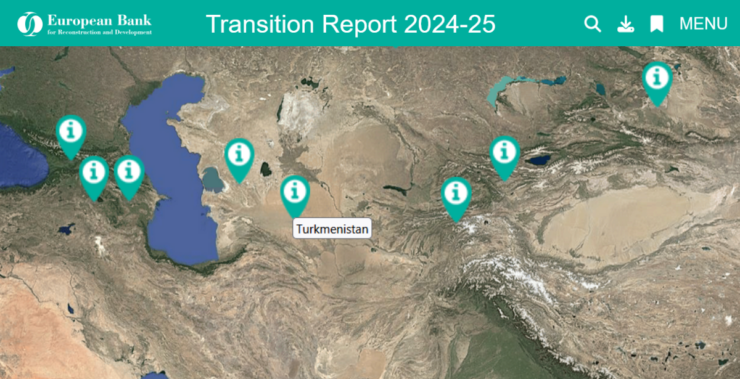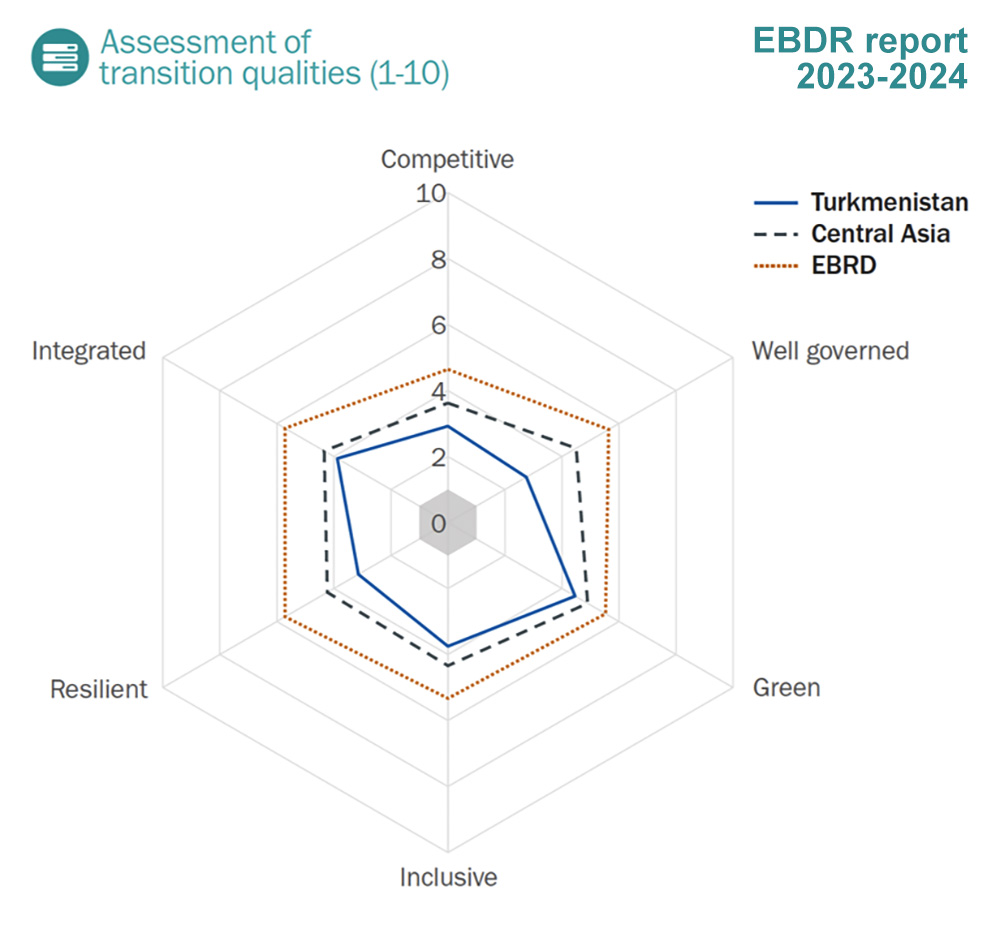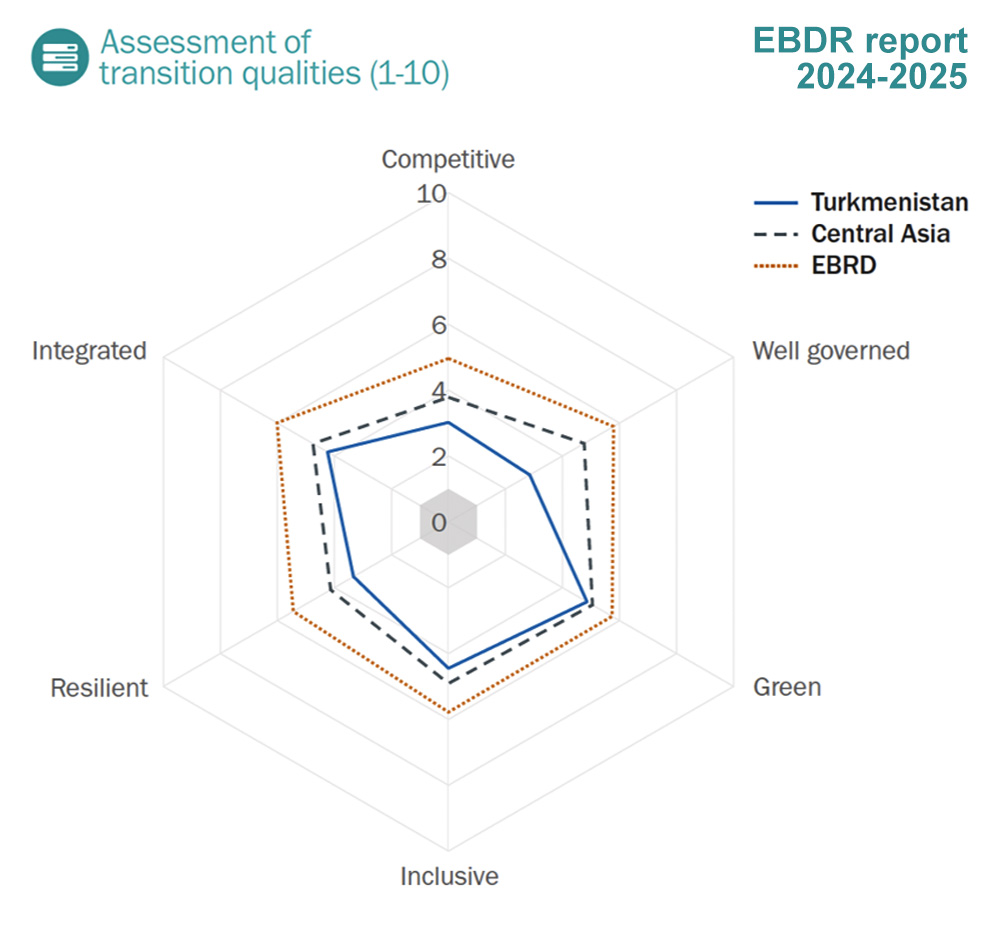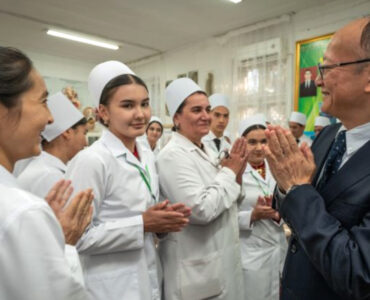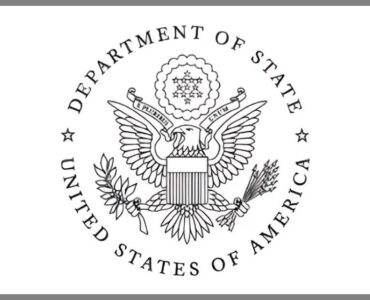The latest Transition Report (2024-25) from the European Bank for Reconstruction and Development (EBRD) on Turkmenistan reveals some changes compared to the previous year’s report (2023-24). EBRD highlighted three priority areas for Turkmenistan for 2025 including – diversifying gas exports, reducing the large gap between the official and parallel exchange rates and rationalising water usage for irrigation needs.
Revision of GDP figures: The new report revised Turkmenistan’s GDP figures for 2023 from 6.5% to 2%. The Bank estimated GDP growth for 2024 as 6.3%. It is mainly driven by government-led investments in infrastructure, and growth in construction (+9.3%), agriculture (+7.8%), and transport (+7.1%). Industrial output rose 3.6%, with strong performance in oil, gasoline, and polypropylene production. A 10.5% wage increase boosted services by 7%.
Currency exchange rates: While in last year’s report EBRD merely noted the difference between official and black market exchange rates, in the 2024-2025 report the Bank noted it as a key priority for Turkmenistan in 2025. The report points out the importance of reducing the large gap between official and parallel exchange rates. According to the EBRD, the dual exchange rate restricts foreign direct investment, encourages emigration and brain drain, and exacerbates the lack of human capital shortages facing the country’s industrial sector.
Decline in inflation rate: While the government does not publish inflation figures, the report cites IMF estimates of 6.3% average inflation in 2024. Last year’s report projected inflation for 2023 at 5.9%, which this year’s report corrected to a negative 1.7%. This means in 2023 Turkmenistan experienced deflation or a decrease in prices in the economy.
Fiscal balance: The fiscal balance is stable, with revenues exceeding expectations by 2.9% and expenditures remaining within targets. Fitch Ratings upgraded Turkmenistan’s credit rating from B+ to BB- (stable) due to strong fiscal discipline, low debt, and rising international reserves (covering 55 months of external payments).
Water shortages: Similar to 2023, the new report underscores the issue of water scarcity as a critical concern for Turkmenistan’s future growth. Turkmenistan has the highest risk of water stress in Central Asia. It stems from the lack of water-saving agricultural crops and technologies, as well as water reuse and recycling.
Donate to support Turkmen analysts, researchers and writers to produce factual, constructive and progressive content in their efforts to educate the public of Turkmenistan.
SUPPORT OUR WORKMethane emissions: Similar to last year, in the 2024-2025 report EBRD focused on methane emissions in Turkmenistan and its efforts to curb the emissions. In 2023, Turkmenistan joined the Global Methane Pledge, approved the 2023-24 Methane Roadmap, and formed an Intersectoral Commission to reduce emissions. In 2024 Turkmenistan established a strategic advisory board with the UN and developed a three-year (2025-28) Green Energy Transition Plan; introduced a law on energy efficiency to promote sustainable energy use and renewable adoption; and the Ministry of Foreign Affairs launched a six-year plan to expand international cooperation in solar, wind, and biomass energy.
Digital initiatives: Turkmenistan is advancing digital trade and regulatory reforms to enhance exports. In July 2024, a single digital window for export-import operations was launched, streamlining e-documentation and reducing transaction costs and corruption risks. The platform aligns with UN and WTO standards. Turkmenistan has also developed a 2024-25 Roadmap with the International Labour Organization (ILO) to combat forced and child labor in cotton harvesting.
Transport: Transport connectivity has significantly improved, with cargo and passenger transport doubling in early 2024 due to infrastructure upgrades. The Turkmenbashi International Seaport is being promoted as a regional transit hub. The Ashgabat-Mary-Lebap highway was completed in spring 2024, cutting travel time between Ashgabat and Mary to under three hours. The final section to Turkmenabat, once completed, will further reduce transit time to Uzbekistan’s border.
The EBRD Transition Report evaluates countries’ progress toward sustainable market economies based on the following six key transition qualities on a scale of 1 to 10, with 10 representing a fully developed market economy.
- Competitive: the degree of market competition, ease of doing business, and innovation.
- Well-Governed: transparency, rule of law, institutional strength, and anti-corruption.
- Green: environmental sustainability, climate policies, and energy efficiency.
- Inclusive: equal economic opportunities, gender equality, labor market access, and income distribution.
- Resilient: financial sector stability, economic diversification, and shock resistance.
- Integrated: trade openness, infrastructure connectivity, and regional/global market integration.
When comparing Turkmenistan’s performance on these qualities in 2023-2024 and 2024-2025 (see Figure below) there are slight improvements on indicators such as – green, inclusive and integrated. Improvements are likely the result of Turkmenistan’s effort to reduce methane emissions (green), efforts to combat forced labor in cotton harvesting (inclusive) and introduction of a single digital window for export-import operations and improvements in transport connectivity (integrated). Nevertheless, the real improvements will depend on Turkmenistan’s ability to enforce these changes beyond the paper and political declarations so people can actually experience and benefit from these changes in meaningful ways.

